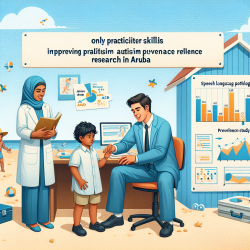Introduction
As practitioners dedicated to improving the lives of children, it is imperative that we continuously seek to enhance our skills and knowledge. One way to achieve this is by integrating the latest research findings into our practice. The recent study titled "Health consequences of exposure to aircraft contaminated air and fume events: a narrative review and medical protocol for the investigation of exposed aircrew and passengers" offers valuable insights that can be leveraged to improve our therapeutic approaches and outcomes.
Understanding the Research
The study delves into the health implications of exposure to contaminated air in aircraft cabins, particularly focusing on the effects of fume events on aircrew health. These events are characterized by the inhalation of potentially toxic fumes, which have been linked to acute and long-term neurological, respiratory, and cardiological symptoms. The research highlights the complexity of assessing these health impacts due to the presence of various toxic substances in the air supply.
Key Takeaways for Practitioners
For practitioners in the field of speech language pathology, the findings of this research underscore the importance of a systematic approach to diagnosis and treatment. Here are some actionable insights:
- Comprehensive Assessment: Implement thorough assessments that consider both the immediate and long-term health effects of exposure to toxic substances. This includes neurological, respiratory, and cardiological evaluations.
- Data-Driven Decisions: Utilize data and evidence-based practices to inform treatment plans. The research provides a framework for recognizing and managing symptoms associated with fume events.
- Interdisciplinary Collaboration: Work closely with other healthcare professionals to ensure a holistic approach to patient care. This is particularly important when dealing with complex cases involving multiple health systems.
- Continued Education: Stay informed about the latest research and developments in the field. Encourage ongoing learning and adaptation of new protocols to enhance therapeutic outcomes.
Encouraging Further Research
The study also emphasizes the need for further research to better understand the health effects of fume events and to develop more effective diagnostic and treatment protocols. Practitioners are encouraged to contribute to this body of knowledge by conducting their own research and sharing findings with the broader community.
Conclusion
By integrating the insights from this research into our practice, we can enhance our ability to provide effective therapy and support to children affected by exposure to toxic substances. Let us continue to strive for excellence in our field by embracing data-driven decisions and fostering a culture of continuous learning and improvement.
To read the original research paper, please follow this link: Health consequences of exposure to aircraft contaminated air and fume events: a narrative review and medical protocol for the investigation of exposed aircrew and passengers.










